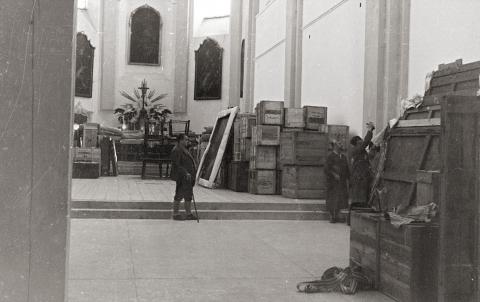On 13 September 1939 Department III of the Reichsstatthalterei in Vienna, which was responsible for the arts, allocated the former charterhouse in Gaming to the Ministry of Internal and Cultural Affairs, Department IV (Education, Culture and Popular Education) for salvaging purposes. The legal basis for use of the property, owned by Melk Abbey and containing a church, refectory, administrative wing, library, garden and grounds, was the Law on Premises for Public Offices adopted on 27 July 1938, which allowed the requisitioning if necessary of both built-up and undeveloped sites. Gaming had in fact already become a salvage depot two weeks before it was requisitioned. At 6 a.m. on 31 August 1939, twenty-eight crates with the most important paintings from the Kunsthistorisches Museum in Vienna (including all works by Peter Bruegel the Elder) had been transported there. Numerous other transports followed. Under the code name "Schloss", Gaming was to become one of the major salvage depots for state museums outside Vienna. Art objects were stored there from various collections of the Kunsthistorisches Museum (Egyptian and Near Eastern, Greek and Roman Antiquities, Coins, Historic Musical Instruments, Sculptures, Arts and Crafts and the Imperial Treasury), the Albertina (until 1940), the State Arts and Crafts Museum in Vienna , the Liechtensteingalerie, the Museum of Ethnology and the Österreichische Galerie. The Städtische Sammlungen Wien and Post and Telegraph Museum in Vienna also transported items for salvage to Gaming. After September 1939, apart from the collection managers and curators of the Kunsthistorisches Museum Fritz Dworschak, Rudolf Noll, Hans Demel, Gert Adriani, Ludwig Baldass, Richard Nadler and Karl Ortner, access to the "Jagd" (Steinbach bei Göstling) and "Schloss" depots was available to researchers from other museums: director Richard Ernst and curator Siegfried Troll from the State Arts and Crafts Museum, director Bruno Grimschitz and curators Kurt Blauensteiner and Fritz Novotny from the Österreichische Galerie, and director Anton Reichel and curator Georg Saiko from the Albertina. The other local staff came exclusively from the Kunsthistorisches Museum: the restorers Wilhelm Kainz and Eduard Kneisel, who were in Gaming permanently, the secretaries Anna Schöpf and Josefine Berger, and some guards and cleaning staff. The local mayors and two Lower Austrian provincial and forestry officials had permission to enter the depots in the monastery building and church. From 1940, a separate agricultural school for girls was housed in the street-facing and connecting tracts of the former charterhouse, along with housing and a kindergarten. During the war the staffing was gradually cut, and in September 1944 the depot was to be cleared because of the increasing fear of air raids on the iron works in Kienberg just 2 km away and on the car park planned by the Wehrmacht for air force supply vehicles in Gaming park. Because of the lack of space, however, only the most important items were moved, mainly to various depots in Vienna. In January 1945 a basement had to be ceded to Armaments Inspectorate XVII for a research laboratory. In the last weeks of the war, a field hospital and refugee accommodation took up additional space. Items were salvaged in Gaming until the end of the war, without any bomb damage. In April 1945 paintings were transferred from there to Salzbergwerk Lauffen, and the depot office worked until 5 May 1945.
On 23 May 1945, the Red Army reached Gaming. With the aid of the Soviet military government, work began in August 1945 on the return of museum objects to Vienna, and the transports were extensively concluded by the following month. A few items from the State Arts and Crafts Museum, the Städtische Sammlungen and some private collections remained in the abbey church until 1946. Only a few pieces of furniture went missing.

